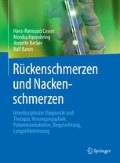Zusammenfassung
Die lumbale Spinalkanalstenose (LSS) ist ein Beschwerdekomplex aus Rückenschmerz und belastungsabhängigen Schmerzen in den Beinen. Die Inzidenz symptomatischer LSS nimmt aufgrund des steigenden Lebensalters der Patienten und des hohen Anspruchs an Lebensqualität exponentiell zu. Nach ausführlicher Anamneseerhebung und klinischer Untersuchung erfolgt eine weiterführende radiologische Diagnostik mittels Röntgen und ggf. Schnittbilddiagnostik. Die Therapie ist in erster Linie vom Beschwerdebild der Patienten abhängig und sekundär vom Ergebnis der bildgebenden Verfahren. Nach Ausschöpfen aller konservativen Maßnahmen im Sinne einer multimodalen Schmerztherapie steht die operative Therapie im Vordergrund. Aufgrund der großen Vielfalt an Operationsmethoden ist es schwierig, einen Behandlungsalgorithmus zu definieren. Die Wahl des Operationsverfahrens sollte immer individuell für den Patienten getroffen werden.
Access this chapter
Tax calculation will be finalised at checkout
Purchases are for personal use only
Literatur
Atlas SJ, Delitto A (2006) Spinal stenosis: surigcal versus nonsurgical treatment. Clin Orthop Relat Res 443:198–207
Atlas SJ, Keller RB, Wu YA (2005) Long-term outcomes of surigal and nonsurgical management of lumbar spinal stenosis: 8 to 10 year results from the maine lumbar spine study. Spine 30: 936–943
Heisel J (2010) Kompressionssyndrome der Hals- und Brustwirbelsäule. Orthopädie und Rheuma 12:37–42
Johnsson KE, Rosen I, Uden A (1992) The natural course of lumbar spinal stenosis. Clin Orthop Relat Res 279:82–86
Klöckner C (2010) Langzeitergebnisse der Dynesys-Implantation. Orthopäde 39:559–564
Meyer F, Börm W, Thomé C (2008) Die degenerative zervikale Spinalkanalstenose. Dtsch Arztebl 20:366–372
Reinhardt A, Hufnagel S (2010) Langzeitergebnisse des interspinösen Distraktionssystems X-STOP. Orthopäde 39:573–579
Resnick DK, Choudhri TF, Dailey AT (2005) Guidelines fort he performance of fusion procedures for degenerative disease of the lumbar spine. Part 10: fusion following decompression in patients with stenosis without spondylolisthesis. J Neurosurg Spine 2:686–691
Resnick DK, Choudhri TF, Dailey AT (2005) Guidelines fort he performance of fusion procedures for degenerative disease of the lumbar spine. Part 9: fusion following decompression in patients with stenosis and spondylolisthesis. J Neurosurg Spine 2:679–685
Schulte TL, Bullmann V, Lerner T, Schneider M, Marquardt B, Liljenqvist U, Pietilä TA, Hackenberg L (2006) Lumbale Spinalkanalstenose. Orthopäde 35:675–694
Siddiqui M, Nicol M, Karadimas E (2005) The positional magnetic resonance imaging changes in the lumbar spine following insertion of a novel interspinous process distraction device. Spine 30:2677–2682
Siddiqui M, Smith FW, Wardlaw D (2007) One-year results of X-STOP interspinous implant for the treatment of lumbar spine stenosis. Spine 32:1345–1348
Thomé C, Börm W, Meyer F (2008) Die degenerative lumbale Spinalkanalstenose. Dtsch Arztebl 20:373–379
Toyone T, Tanaka T, Kato D (2003) Patients’ expectations and satisfaction in lumbar spine surgery. Spine 30:2689–2694
Tulder M van, Becker A, Bekkering T (2006) Chap. 3 European guidelines fort he management of acute nonspecific low back pain in primary care. Eur Spine J 15:169–191
Tulder MW van, Koes B, Seitsalo S, Malmlvaara A (2006) Outcome of invasive treatment modalities on back pain sciatica: an evidence-based review. Eur Spine J 15:82–92
Zeitfang F, Abel R, Schiltenwolf M (2003) Möglichkeiten konservativer Beahndlungsmethoden bei Patienten mit Claudicatio spinalis. Orthopäde 32:906–910
Zucherman JF, Hsu KY, Hartjen CA (2005) A multicenter, prospective, randomized trial evaluating the X-STOP interspinous process decompression system for the treatment of neurogenic intermiitent claudication: two-year follow-up results. Spine 30:1351–1358
Author information
Authors and Affiliations
Editor information
Editors and Affiliations
Rights and permissions
Copyright information
© 2016 Springer-Verlag Berlin Heidelberg
About this chapter
Cite this chapter
Richter, R., Richter, S., Forst, R. (2016). Spinalkanalstenose. In: Casser, HR., Hasenbring, M., Becker, A., Baron, R. (eds) Rückenschmerzen und Nackenschmerzen. Springer, Berlin, Heidelberg. https://doi.org/10.1007/978-3-642-29775-5_41
Download citation
DOI: https://doi.org/10.1007/978-3-642-29775-5_41
Publisher Name: Springer, Berlin, Heidelberg
Print ISBN: 978-3-642-29774-8
Online ISBN: 978-3-642-29775-5
eBook Packages: Medicine (German Language)

